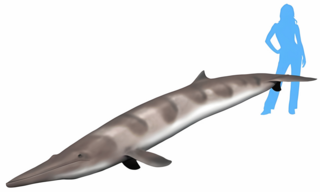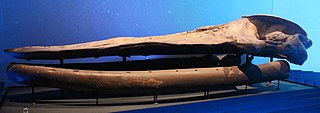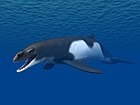
Neobalaenidae is a family of baleen whales including the extant pygmy right whale. Although traditionally considered related to balaenids, recent studies by Fordyce and Marx (2013) and Ludovic Dutoit and colleagues (2023) have recovered the living pygmy right whale as a member of Cetotheriidae, making it the only extant cetotheriid. Not all authors agree with this placement.

The Cephalocarida are a class in the subphylum Crustacea comprising only 12 species. Both the nauplii and the adults are benthic. They were discovered in 1955 by Howard L. Sanders, and are commonly referred to as horseshoe shrimp. They have been grouped together with the Remipedia in the Xenocarida. Although a second family, Lightiellidae, is sometimes used, all cephalocaridans are generally considered to belong in just one family: Hutchinsoniellidae. Fossil records of cephalocaridans have been found in the Ordovician Castle Bank site.

Cetotherium is an extinct genus of baleen whales from the family Cetotheriidae.
Joumocetus is a genus of extinct baleen whale in the family Cetotheriidae containing the single species Joumocetus shimizui. The species is known only from a partial skeleton found in Miocene age sediments of Japan.

Cetotheriidae is a family of baleen whales. The family is known to have existed from the Late Oligocene to the Early Pleistocene before going extinct. Although some phylogenetic studies conducted by Fordyce & Marx 2013 recovered the living pygmy right whale as a member of Cetotheriidae, making the pygmy right whale the only living cetotheriid, other authors either dispute this placement or recover Neobalaenidae as a sister group to Cetotheriidae.

Herpetocetus is a genus of cetotheriid mysticete in the subfamily Herpetocetinae. Considerably smaller than modern baleen whales, Herpetocetus measured only 3 to 4 meters in length. Additionally, due to the structure of its jaw, it was unable to open its mouth as wide as modern baleen whales, making it incapable of lunge feeding.
Peripolocetus is a genus of balaenid baleen whale from the middle Miocene of Kern County, California.

Mixocetus is a genus of extinct baleen whale belonging to the family Tranatocetidae. It is known only from the late Miocene (Tortonian) of Los Angeles County, California.

Tranatocetus is an extinct genus of mysticete from the late Miocene (Tortonian) of Jutland, Denmark. The type and only species is Tranatocetus argillarius.

Brandtocetus is a genus of cetotheriid mysticete in the subfamily Cetotheriinae. The type and only species is Brandtocetus chongulek from the late Miocene (Tortonian) of the Kerch Peninsula in Crimea.
Allodelphinidae is a family of primitive platanistoid river dolphins found in marine deposits in the eastern North Pacific region, Alaska, and Japan.

Mithridatocetus is a genus of cetotheriid mysticete in the subfamily Cetotheriinae. Known specimens have been found in marine deposits in Crimea, Ukraine, and the Russian Caucasus.
Kurdalagonus is a genus of cetotheriid mysticete in the subfamily Cetotheriinae from the Miocene of the Russian Caucasus.
Eucetotherium is a genus of cetotheriid mysticete from Miocene (Tortonian) marine deposits in the Russian Caucasus.
Vampalus is a genus of cetotheriid mysticete from Miocene (Tortonian) marine deposits in the Russian Caucasus. The type species, V. sayasanicus, is based on PIN 5341/1, a complete skeleton. The cetotheriid Eucetotherium helmersonii was mistakenly assigned to Vampalus by Tarasenko and Lopatin, who were unaware that Kellogg (1931) fixed "Cetotherium" helmersonii as the Eucetotherium type species.

Cotylocara is a genus of primitive odontocete from late Oligocene (Chattian) marine deposits of the Chandler Bridge Formation of South Carolina. It belongs to the Xenorophidae.

Tiucetus is an extinct genus of cetotheriid baleen whale known from the Late Miocene Pisco Formation of Peru.
Herentalia is a genus of cetotheriid mysticete in the subfamily Herpetocetinae. Remains have been found in Late Miocene marine deposits in Belgium.
Otradnocetus is an extinct genus of baleen whale from the middle Miocene of the Russian Caucasus.
Taikicetus is a genus of basal thalassothere baleen whale from the Middle Miocene of Japan.














